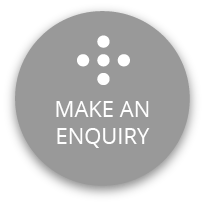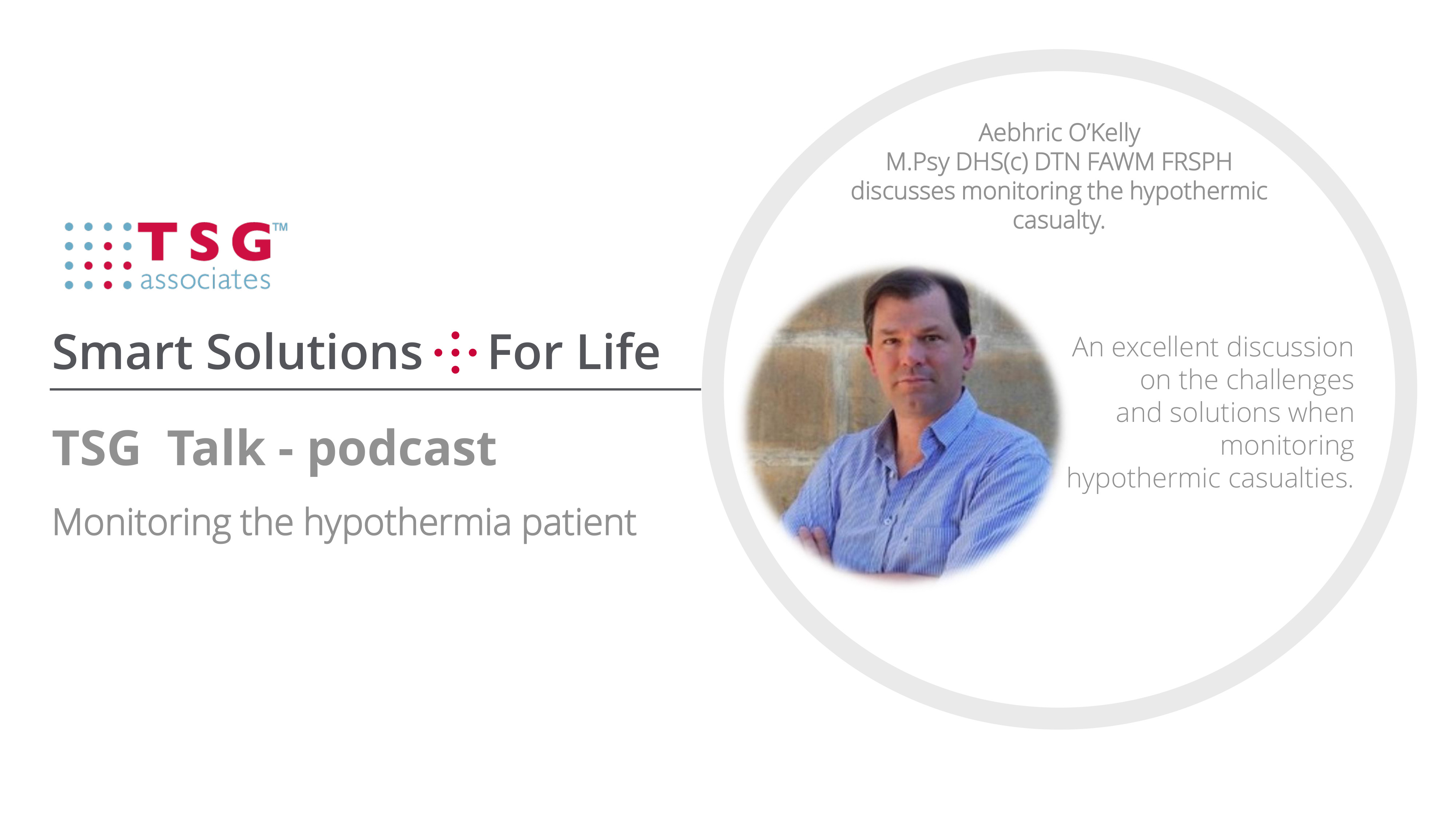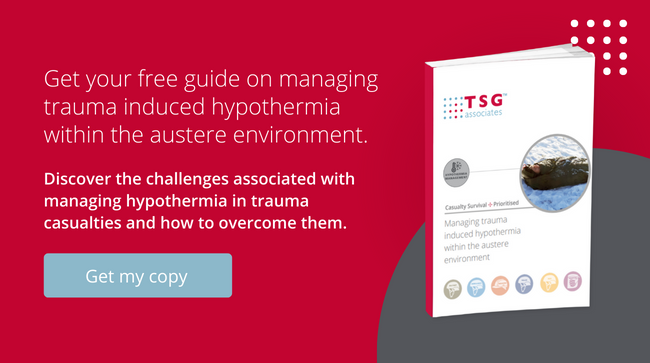


03/10/2022
TSG Talk - Monitoring the hypothermic casualty
In a recent instalment of our podcast series, Senior Partner, Colin Smart, spoke with Aebhric O'Kelly, the Executive Dean for the College of Remote and Offshore Medicine Foundation. Together, they discussed the critical subject of hypothermia treatment, exploring its significance, the hurdles in its prevention, and a wealth of invaluable insights.
Background
Aebhric first explains his background and why he focuses on hypothermia.
“I am a former U.S. Army Green beret… I decided to go to the US side for military experience, I spent ten years as a green beret on the ODI's there. After that, I popped over to this side of the pond, and I started a non-profit called the College of Remote and Offshore Medicine Foundation… based in Malta. We’re a degree-granting institution; we've got doctorates, master's and bachelor's degrees focusing on austere medicine of healthcare and difficult environments. We spend a lot of time thinking about how to improve outcomes in the remote and austere environments…. Even … if you look at sub-Saharan Africa, it's 40 degrees Celsius out. You have a casualty, a traumatic casualty, and you're dealing with them, and you're sweating… you know, it's hot. So, hypothermia is everywhere. So this is a very important topic we focus on in our non-profit.”
Scoop-and-run is ineffective
He then explains why hypothermia is not appropriate for the scoop-and-run system.
“ …Working as a paramedic in quite a few different countries. It's the whole scoop-and-run mentality that was killing us. We're like… we can see the hospital. I just scoop this guy up and take him there, will be there in 20 minutes. I don't have to worry about wrapping the casualty. Well, that's wrong, that's killing people. So the mentality that we have of … we'll be there shortly is not … good medicine. So from the very beginning … as you roll the casualty, to assess the back… you have to put something fluffy down underneath them to deal with hypothermia. Hypothermia should be addressed as soon as possible. And yes, we deal with this in E when we do this CBACEDE or if you're tactical, use March and H is the hypothermia and head injuries. So we're doing this after our assessment of airway, breathing, and circulation. But perhaps we should think about it a little more aggressively and if you can get them wrapped up earlier than all the way down to E assessment.”
Research
Aebhric explains how his college is conducting research into hypothermia.
“Just basing this off of research, we see that … hypothermia is such an easy fix in the assessment progress. So one of the benefits of running the college is that we can institute new concepts immediately into our remote paramedic programme, our masters of osteoporotic care programme. So during scenarios… we have live casualties that are made-up with some of them are amputees… we get them all bloody, and we try this out with our prolonged field care. Even though whilst we're in Malta, which is hot, so these casualties who are not really traumatic, are … getting cold because you're laying on concrete. My paramedics, my EMT's are docs who are in the masters programme, don't cop on to that fact. And being in the academic environment, we can look at current research and then try out new concepts as well as come up with ways that work and don't work.”
Aebhric continues by explaining how he encourages evidence-based medicine.
“What I love about my job is that I can have someone who's in a remote EMT programme, doesn't know medicine to save their life. They did their hundred hours of online. They're coming for the six days of classroom, and they're coming up with, like, weird, weird things. I'm…looking at this casual and like, who did this? What? What is this, guys? Oh, I'm sorry. No, no, I did this. No, that's brilliant. Let's try this… This patient gets it this way. This patient gets the other let's try it. So, at the college, we're trying to push evidence-based medicine forward. So what we've been pushing lately is how to wrap the casualty and still being able to assess. So we've come up with a pretty good way of getting all the kits and bits and bobs attached to the casualty. One up to the nape of the neck so you don't have to continually unwrap the casualty when you do your assessments. And so far, we've had some pretty good results. Nothing publishable yet because it's case study anecdotal, but we seem to be able to wrap up the casualty and not have to unwrap them whilst we're doing our critical assessments.“
Difficulty of taking temperature
He then discusses the difficulty of taking the temperature of hypothermia casualties.
“Getting accurate temperature is difficult. Come on, it's rectal temperature, isn’t it, that's the evidence based in an austere environment. I'm just not going to be doing that with the probes that we have. With the hypothermia, I'm not doing that because I'm going to have to expose them drastically to get the rectal probe in to get the core temperature. Tympanic has got some good research, but it's all done in a clinic where it's not cold, so tympanic temperatures is just not accessible in hypothermic or environmentally cold areas because the air is just gonna be colder. And so we have … gone with axillary on attempts, and there's some published research out there. I put it on some of my LinkedIn articles that it's about 0.33 degrees celsius colder than core temperature. I was always taught one-degree difference, and then I did some research on an article I was… reading, and the actual temperature is pretty close to what you have. So what we're doing is we're getting some high-quality plant thermometers, and the plant thermometer has this long wire lead with this metal probe, and we put that underneath the axilla. We tape it down and then put the arm down so it stays in place, and then you're running the lead up to the side of the head along with your BP cough… ECG and everything else is right there. And we're finding that as a good way to get temperature. Now, trending is probably more important than actual. So yeah, some people are gonna say… there's no way you're gonna get core temperature with axilla. Actually, you're right… science shows it's about… 0.33 degrees less, but even then, I'm looking at trending because it's a plant thermometer. It is not medical by any means. So we're looking …every 5 minutes. What is it? If it's dropping from whatever we started with, I'm losing cool points, and my team sucks, but if I’m seeing an increase, then we’re doing the right things.”
What advice would you give our listeners?
Aebhric then gave his advice on how to enhance future care.
“So we talked about the plant thermometer having a thermometer with a wired probe under the armpit. Second is running your stethoscope underneath your BP cuff and securing it with clingfilm to the arm and then putting your BP cuff upside down, running your staff underneath the BP cuff and then having everything led to the shoulder and you can get your BP using that method. Even though this stuff is running underneath the BP. And the same with the three lead ECG. So now the EGS’s are so small nowadays that they should be on every kit. So you place your three or four leads and run the leads up to the shoulder. So now you have your temp, you have your BP, you have your ECG. All there, right next to the shoulder and you don't have to unwrap your casualty at all.”
What is your essential medical equipment?
He then explained how ultrasound was his equipment of choice.
“That’s easy, ultrasound. Always ultrasound. There is very little out there you can’t use an ultrasound for, and you are losing cool points if you’re a medic and you do not have an ultrasound on you.”
Find out more
Click here to listen to the full TSG Talk episode with Aebhric, to find out more about our life-saving solutions please call TSG Associates on 01422 557841 or email the team at info@tsgassociates.










